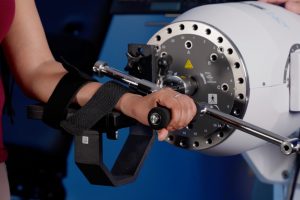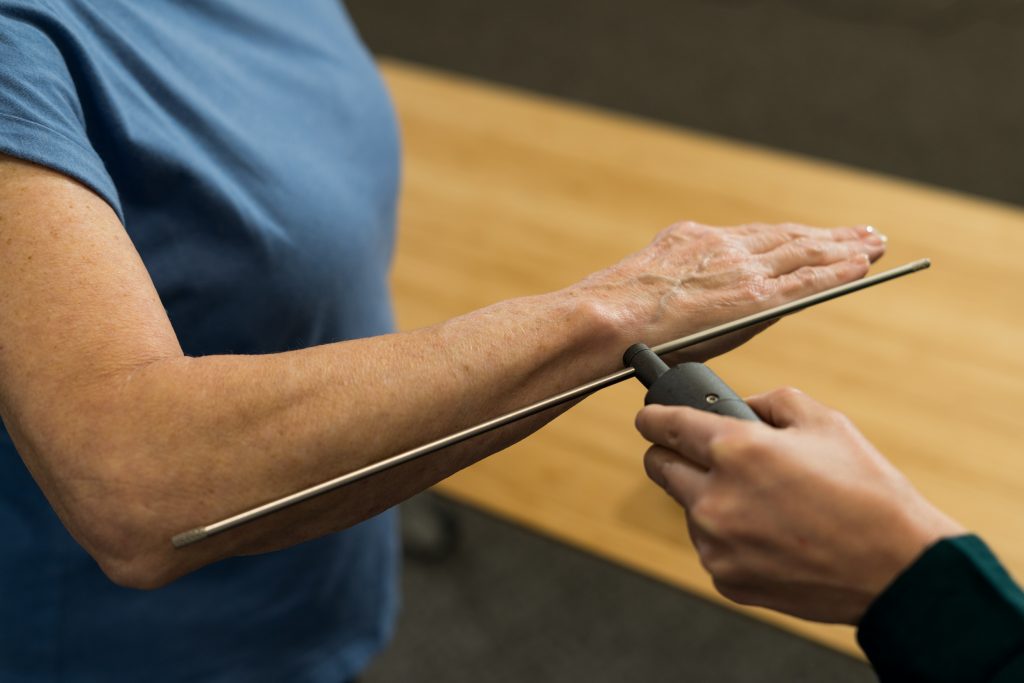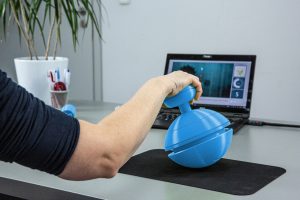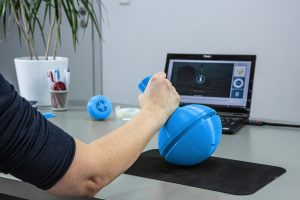
Wrist Flexion and Extension: A Guide to Measuring, Testing, and Improving Range of Motion and Strength
Treatment GuidelinesDiscover how to measure, test, and strengthen wrist flexion and extension using clinical tools, functional exercises, and targeted rehab protocols.
Living with compromised wrist flexion and extension can be devastating. These movements are so fundamental, patients often take them for granted until they’re lost.
Wrist flexion brings the hand toward the palm, while wrist extension moves it back toward the back of the hand. These essential movements are critical for nearly every functional activity our patients perform, from pushing doors open to typing.
Understanding proper measurement, testing, and rehabilitation of these movements is essential for effective treatment plans and tracking progress. In this article, we’ll explore clinical assessment techniques, measurement protocols, and rehabilitation strategies to optimize outcomes for patients with wrist dysfunction.
Understanding Wrist Flexion and Extension
Let’s be honest, wrist function is far more complex than we often give it credit for in our daily documentation. Wrist flexion and extension movements involve intricate interactions between the radiocarpal and midcarpal joints, with coordinated muscle activation patterns that determine both movement quality and functional capacity. The primary muscles responsible for wrist flexion include the flexor carpi radialis and flexor carpi ulnaris.¹ Extension relies on the extensor carpi radialis longus, extensor carpi radialis brevis, and extensor carpi ulnaris.¹
What makes wrist assessment particularly challenging is how these movements integrate with overall hand function. Research analyzing hand movement functionality reveals that coordinated wrist movements are fundamental to effective grasp patterns – something we see compromised daily in our patients with various conditions.² The wrist experiences substantial biomechanical loads during routine activities, with forces that can significantly impact joint health and function over time.¹
From a clinical perspective, wrist extension deserves special attention since it’s necessary for functional grip patterns and serves as a predictor of upper limb recovery.³ Understanding these movement patterns helps us develop more targeted and effective interventions that actually translate to functional improvements our patients can feel.
Manual Muscle Testing for Wrist Flexion and Extension
We’ve all been there – performing manual muscle testing with the 0-5 grading scale, knowing we’re only getting a snapshot of our patient’s true functional capacity. For wrist flexion testing, we position patients seated with the forearm supported in supination, applying resistance through the palm for grades 4-5. Extension testing follows similar principles with the forearm in pronation and resistance applied to the dorsum.
While MMT provides standardized documentation from 0 (no contraction) to 5 (normal strength against maximum resistance), it has inherent limitations we rarely discuss openly. The subjective interpretation and limited precision for detecting subtle changes can leave us wondering if patients are truly improving.
Here’s the thing – MMT is the most common measurement technique in rehabilitation, but modern assessment tools offer a better way to measure with greater precision, accuracy, and repeatability. For example, BTE’s rehab equipment is designed to measure every type of movement, from fine isolated hand movements to functional activities like an overhead reach. This objective data enhances your clinical decision-making and supports more effective treatment planning in a way that manual testing methods alone can’t.
In addition to better measurement capabilities, providing objective performance data can also enhance patient engagement. When you show your patients their baseline measurements and concrete improvements with real numbers, charts, and graphs, it often becomes a turning point in their motivation and engagement with therapy. This is especially true for patients with long-term conditions who need that extra boost of confidence to continue with treatment.
How to Measure Wrist Flexion and Extension with a Goniometer
Goniometric measurement can establishes range of motion baselines and progress tracking. Using a plastic goniometer is very common, but not the most accurate or consistent way to measure flexion and extension. Since most clinicians have easy access to this simple tool, here’s how to measure wrist movement with a goniometer.
Wrist Flexion Measurement: Position your patient seated with shoulder abducted to 90 degrees, elbow flexed to 90 degrees, and wrist positioned over the table edge with forearm in pronation. Place the goniometer axis over the lateral triquetral bone, align the stationary arm parallel with the ulna of the forearm, and position the movement arm parallel with the longitudinal axis of the 5th metacarpal.4 Normal range: 75-90 degrees.
Wrist Extension Measurement: Use identical positioning as flexion testing. Goniometer placement remains consistent: axis over lateral triquetral bone, stationary arm parallel with ulna, movement arm parallel with 5th metacarpal’s longitudinal axis.4 Normal range: 0-70 degrees.
Values significantly below these ranges may indicate joint restriction, muscle weakness, or pathological conditions requiring intervention. We’ve all experienced frustrating moments with inconsistent measurements between sessions, wondering if patients actually improved or if it’s measurement error. Common culprits include improper axis placement, inadequate stabilization, and inconsistent landmark identification.
Traditional plastic goniometers are prone to measurement variability and human error that frankly drives us all crazy sometimes. Here’s where technology can actually help us do our jobs better. A digital goniometer is a more scientific and clinically advanced approach, offering improved accuracy and objective data recording that addresses these limitations while still being practical for everyday use.
For example, BTE’s Evaluator and EVJ include digital goniometers that provide better measurement of wrist flexion and extension (as well as any upper or lower extremity joint, and the cervical spine). These advanced measurement tools provide more consistent testing, reliable objective data, and automated reporting to support your documentation.

Rehab Exercises for Wrist Flexion and Extension
Now this is where we can really make a difference. Effective rehabilitation programs need to address both range of motion and strength while considering what our patients need to do in their real lives. Range of motion exercises should progress logically from passive to active movements based on healing constraints and what your patient can tolerate that day.
Research confirms what many of us have observed clinically – strengthening exercises are effective for improving pain, function, and grip strength when we implement them thoughtfully.⁵ Hand therapy approaches work best when they integrate functional movement patterns rather than isolated, tedious exercises that patients struggle to adhere to.
The evidence shows us that combined interventions addressing multiple components simultaneously produce superior outcomes compared to single-intervention strategies.⁵ Think about it – when does your patient ever use isolated wrist flexion in real life? They don’t. They’re reaching for a coffee cup, opening a jar, or typing an email. That’s why it’s essential to include functional exercises and realistic task simulation as part of your rehab program.
Strength-building exercises could include wrist curls with resistance bands, therapy putty exercises, and progressive loading activities that make sense functionally. For chronic wrist conditions, research supports combining wrist stability training with grip strength exercises, showing significantly greater improvements in pain reduction and functional outcomes.⁶ Start with 2-3 sets of 10-15 repetitions and progress based on what your patient can handle and their functional goals.
The PrimusRS offers comprehensive wrist flexion and extension exercise protocols with precise resistance control and objective feedback. This system enables us to provide measurable, repeatable exercise programs that enhance patient motivation through concrete progress tracking while ensuring optimal loading for tissue adaptation – something that’s hard to achieve with traditional methods alone. The PrimusRS also offers the unique feature of being able to simulate activities of daily living accurately like opening a jar, turning a key etc.
Tools to Support Assessment and Recovery
Let’s talk about the tools that make a difference in our practice. Basic tools include goniometers for range of motion measurement, wrist splints for positioning support, and resistance bands for strengthening exercises. But honestly, these traditional tools only get you so far in clinical practice.
Functional rehabilitation equipment like the PrimusRS and Capri complement traditional tools by offering superior measurement and treatment capabilities. PrimusRS does it all – upper and lower extremity evaluations and treatment with objective measurement, personalized dosing, and task simulation. The ability to simulate real-world tasks transforms traditional therapy into truly functional rehabilitation that actually prepares the client for returning to those activities. In addition to its versatile exercises, it also provides detailed progress reports with objective data on your patient’s progress.
More specific to the wrist, the Capri is a hand therapy gaming device that provides fun, interactive activities that keep patients engaged. Advanced hand rehabilitation tools provide objective data about strength, endurance, and movement quality that traditional methods simply cannot capture. Capri combines rehabilitation with engaging activities that improve patient adherence while providing us with detailed performance metrics for treatment planning and progress documentation – something that makes our documentation so much more meaningful.
When to Reassess or Refer
We all know that sinking feeling when patients aren’t progressing as expected. Regular reassessment using consistent testing methods is crucial for tracking progress, but sometimes we need backup.
Consider specialist referral when patients present with nerve involvement signs, chronic stiffness unresponsive to conservative treatment, or complex pain patterns requiring advanced diagnostic evaluation.
Treatment modification indicators include strength or ROM plateaus lasting 2-3 weeks, persistent pain during functional activities, or inability to progress despite adequate mobility and strength on paper.
Consistent documentation using standardized measurement tools supports clinical decision-making and makes conversations with referring physicians more productive when presenting objective data.
From Evaluation to Recovery
Here’s what we’ve learned about treating wrist dysfunction: successful rehabilitation requires comprehensive assessment, evidence-based treatment selection, and consistent progress monitoring. Clinical expertise combined with advanced measurement technologies provides optimal patient care with objective data. Functional rehabilitation that simulates real-world activities in the clinic is the best way to restore function and confidence for your patients.
Using the right tools – from goniometers to advanced systems like PrimusRS and Capri – enhances recovery through precise feedback and measurable progress. Objectively demonstrating objective improvements in range of motion, strength, and function of the wrist enhances our clinical practice and patient outcomes. Wrist flexion and extension are essential to everyday life, and with the right tools and techniques, we can track and improve them for our patients.
Hannah le Roux, OTR/L, CHT, is an experienced Occupational Therapist and Certified Hand Therapist with over two decades of international practice across South Africa, the United Kingdom, and the United States. Now, Hannah leverages her extensive expertise as a consultant, guiding fellow therapists in clinical patient care strategies and authoring insightful articles.






